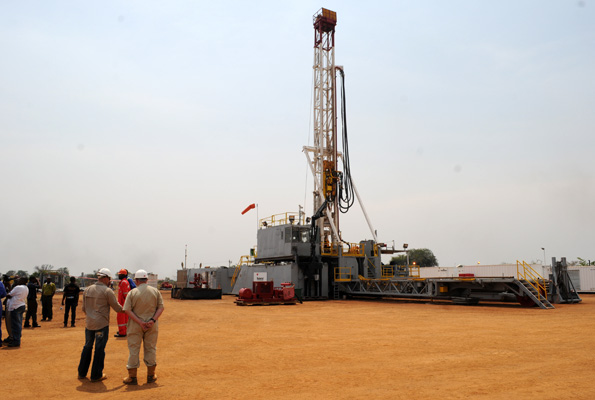
Uganda has so far discovered 6.5 billion barrels of oil resources in 40% of the explored area in the Albertine graben.

An oil rig in Bullisa. About 60 per cent of the oil-rich Albertine
OIL PRODUCTION
The government has set up a resettlement planning committee for persons affected by the oil industrial area to be established in Buliisa district.
The oil companies – Total E&P and Tullow – facilitated the election of 37 members to the committee from the project affected persons (PAPs).
The setting up of the committee is part of the preliminary activities as the oil companies embark on the development phase of Uganda’s budding oil industry.
Uganda intends to start oil production in 2020 and has so far discovered 6.5 billion barrels of oil resources in 40% of the explored area in the Albertine graben.
The oil industrial area to be established in Kasenyi village in Ngedwo sub county will include, among others, the Central Processing Facility (CPF), construction camps, accommodation facilities, a workshop and feeder pipelines.
The joint venture partners – Total E&P, Tullow and CNOOC – have named the oil industrial area in Buliisa after an antelope.
The three oil companies coined a name for the petroleum project from a combination of local names of an antelope in Bunyoro and Acholi – Tilenga. The antelope is called Engabi in Bunyoro and Til in Acholi.
In a statement, the oil companies said the roles of the committee will, among others, include representing the interests of the PAPs and obtaining their input on the project as well as providing regular feedback to the affected people on the progress of the first resettlement action plan (RAP1) for the Tilenga project.
The industrial area and associated access roads will be established on 310 hectares in Kasenyi village.
“The RAP1 committee will also assist in the mediation and reconciliation of grievances that cannot be resolved at the second level of the grievance mechanism and assist in the legal due diligence of the land register,” the oil companies stated.
The committee was constituted on August 4 in Kasenyi village through a secret ballot. It is composed of representatives from Kasenyi local leadership, Ngwedo sub-county, government, project developer and PAPs.
The Buliisa CPF will be used to extract water, associated gas and other impurities such as sand and additives used to enhance petroleum production, from crude oil produced from EAs (Explorations Areas) in Buliisa and Murchison Falls National Park.
The crude oil produced from EA1 and EA2 located in Buliisa and part of Murchison Falls National Park situated in Bunyoro and northern Uganda, will be moved through feeder pipelines to the refinery in Kabaale in Hoima after extracting from it water and associated gas as well as other impurities.
There will be another CPF located in Buhuka in Hoima district to handle crude from the Kingfisher Development Area to the refinery.
Tilenga and Kingfisher are projected to produce 200,000 and 40,000 barrels of crude oil per day respectively for the refinery and the crude pipeline. The refinery is expected to process 30,000 barrels of crude oil per day in the initial phase and 60,000 later after upgrading it.
The 1,445km-long crude pipeline from Hoima to Tanga sea port in Tanzania is expected to carry 216,000 barrels of crude oil to the international market daily.
SOURCE: The New Vision

